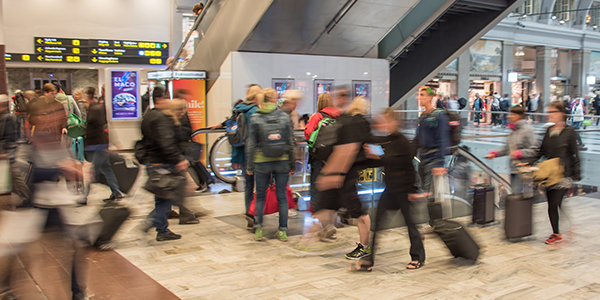If more people are to choose sustainable travel, then the public transport stations of the future must be designed so that pedestrians can get where they are going quickly, without congestion or queues. The Swedish Road and Transport Research Institute (VTI) is developing methods for simulating how pedestrians move around in stations.

“It’s about striking a balance when designing a station, and that’s rather difficult”.
Photo: Mostphotos
The importance of public transport stations that function smoothly is perhaps best illustrated by considering the alternative. Imagine a station so crowded with people that one must push to move forward while constantly stepping aside for oncoming people. This situation is not only annoying but also worrisome in terms of whether one will catch one’s train or bus. In such cases it will not matter that the buses are on time or that the trains are comfortable – the trip will still be experienced as stressful, and driving one’s car instead will be an attractive option.
Building transport stations so large that there is always plenty of room for pedestrian traffic is not so helpful either. The distances to be walked when making a transfer may be so great that the situation again becomes stressful.
“It’s about striking a balance when designing a station, and that’s rather difficult”, said Fredrik Johansson, who is researching pedestrian traffic simulation at VTI.
Flows of pedestrians began to be simulated as early as the 1970s in Japan, which was not easy, given the limited computing power of the time. The best-known site where simulations have been used is the area around the Kaaba, a holy building in Mecca. Following a series of accidents in the 1990s in which many pilgrims were trampled to death, simulations were used to better regulate the huge streams of people.
Commercial software applications are currently available for simulating pedestrian traffic, and are used primarily in designing new stations and renovating old ones. They can be used to create digital representations of how people would move around at various times of day in a hypothetical station. These programs are based on a microscopic model, which means that they take into consideration the fact that different individuals move in different ways.
“Some people want to walk quickly, others a bit more slowly. How far we want to be from other people varies as well”, said Johansson.
The same model can be used worldwide, but the parametric values vary depending on the location.
“People do not move around in the same way in Tokyo as they do in Stockholm. There are strong indications that variations exist even within Sweden, and we cannot assume that people move around in the same way in Stockholm as they do in Gothenburg”.
Johansson is working on refining the models used to simulate pedestrian traffic. He has filmed how people move around at Stockholm Central Station, to study each step they take. One parameter he has studied is relaxation time, which concerns how quickly a person reacts to an obstacle and swerves to avoid it.
“Some of my research concerns the fact that people actually swerve more quickly in reality than in the model. This means that there is a need to improve the model in that regard”.
Johansson has also shown that people want to move more quickly during the morning rush hour than during the evening rush hour. The fact that people’s desired pace varies during the day further complicates the simulations.
At a station there will be not only the people who are walking, but also many who are waiting. Johansson can model such waiting and see how it affects the pedestrian flow. In his work at Stockholm Central Station he could clearly discern how the placement of an information sign often caused people who were waiting to stand in the way of those who were walking.
The overarching goal of Johansson’s work is to make public transport more attractive. Sweden’s municipalities and county councils share the goal of doubling the number of trips made using public transport by 2020. To achieve this goal, the trips must go smoothly in their entirety, from door to door, and that includes those stretches that travellers must walk at a station.
“It feels important to be helping to create better public transport. That’s my biggest motivation in this work”.
Contact:
 Fredrik Johansson
Fredrik Johansson
Fredrik.johansson@vti.se
VTI, Sweden






Follow us: